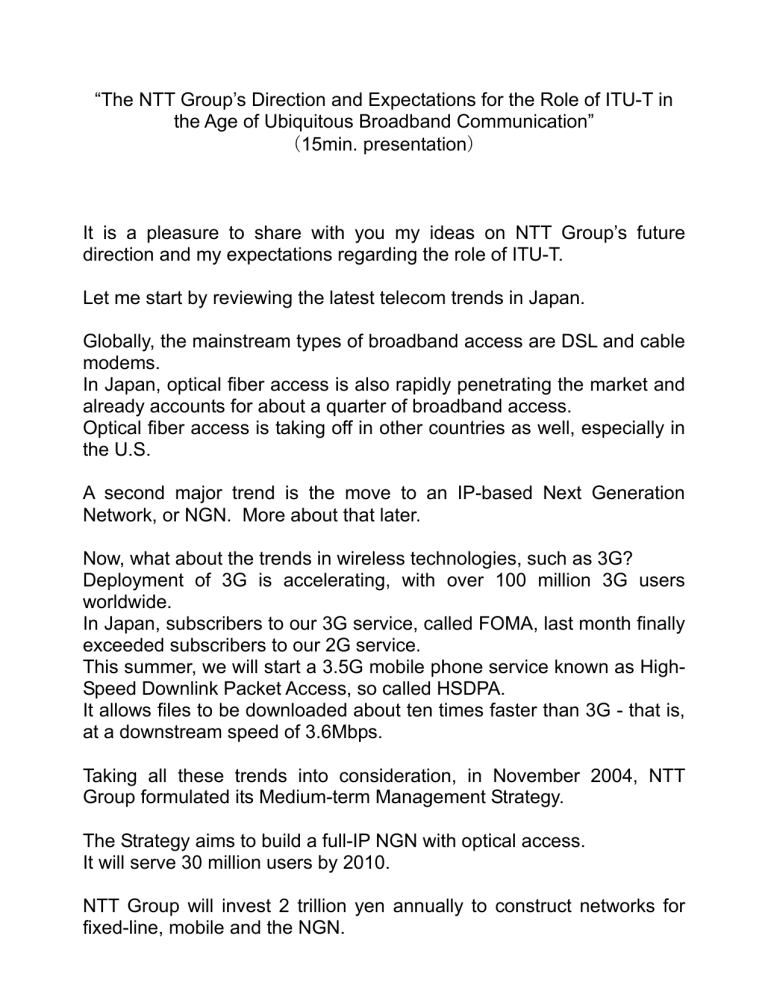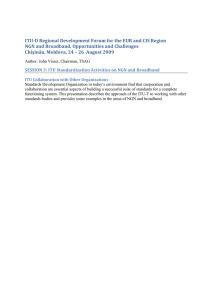“The NTT Group’s Direction and Expectations for the Role of... the Age of Ubiquitous Broadband Communication”

“The NTT Group’s Direction and Expectations for the Role of ITU-T in the Age of Ubiquitous Broadband Communication”
( 15min. presentation )
It is a pleasure to share with you my ideas on NTT Group’s future direction and my expectations regarding the role of ITU-T.
Let me start by reviewing the latest telecom trends in Japan.
Globally, the mainstream types of broadband access are DSL and cable modems.
In Japan, optical fiber access is also rapidly penetrating the market and already accounts for about a quarter of broadband access.
Optical fiber access is taking off in other countries as well, especially in the U.S.
A second major trend is the move to an IP-based Next Generation
Network, or NGN. More about that later.
Now, what about the trends in wireless technologies, such as 3G?
Deployment of 3G is accelerating, with over 100 million 3G users worldwide.
In Japan, subscribers to our 3G service, called FOMA, last month finally exceeded subscribers to our 2G service.
This summer, we will start a 3.5G mobile phone service known as High-
Speed Downlink Packet Access, so called HSDPA.
It allows files to be downloaded about ten times faster than 3G - that is, at a downstream speed of 3.6Mbps.
Taking all these trends into consideration, in November 2004, NTT
Group formulated its Medium-term Management Strategy.
The Strategy aims to build a full-IP NGN with optical access.
It will serve 30 million users by 2010.
NTT Group will invest 2 trillion yen annually to construct networks for fixed-line, mobile and the NGN.
We will enable various players to provide a wide range of services on top of our networks, and we’ll actively seek such alliances.
Field trials will start this December.
We will soon announce the interfaces and interconnection conditions for applications and terminals for our NGN field trials, and then accept applications for the trials.
The NGN will be the backbone of Japan’s economic and social infrastructure --- and for achieving the Japanese government’s growth strategy.
Collaboration among various players will create new businesses and services as well as raise productivity.
Let me touch on a few uses for the NGN and ICT in a ubiquitous broadband environment.
First some background: right now Japan is in a population crisis.
The birthrate is shrinking. By 2015, a quarter of the population will be 65 or older. This will rise to one-third by 2050.
As the productive population declines and the demand for medical care goes up, the NGN and ICT will make important contributions.
One area will be in remote medical diagnosis and monitoring.
For example, broadband network enables pathologists in a large hospital to diagnose patients in distant areas.
It can also connect the homes of sick and elderly people to a nursing center.
This type of system should reduce the cost of nursing care.
The second area of application is for a safe and secure society. As an example, we’ve developed an emergency notification system to help citizens in a disaster.
This system is already used by some governments for disaster prevention and management.
The third area is enhancing productivity and work opportunities.
One way this can happen is using broadband for remote working.
A specific example is a virtual factory of digital maps, in which workers at home make and maintain digital maps.
The NGN and ICT also support new types of products and services.
Right now we’re involved in trials for a digital cinema service.
Super-high-definition video, with 8 Mega-pixel resolutions, is delivered over an optical network from Hollywood to theaters in Tokyo and Osaka.
Finally, I would like to express NTT’s high hopes for ITU-T.
Japan has been a member of the ITU since its beginning and also served on the Council for many years.
In addition, NTT Group’s professionals have been appointed to ITU’s important posts.
NTT Group will continue to contribute to ITU.
It’s taken for granted that the conventional telephone networks around the world are interconnected.
We need to ensure interconnectivity in the NGN as well.
In addition, NGN should combine the high quality and reliability of the conventional telephone network, and the flexibility and cost effectiveness of the IP network.
In the past, the IP network standards have been mainly de facto. But, considering NGN performance requirements, we need de jure standards for that network.
This need makes ITU-T’s role even more critical.
Without ITU-T’s work in this area, telecoms cannot build global NGN as robust and reliable as conventional networks.
I have high hopes that ITU-T will effectively address this essential need.
This brings me to the end of my speech today.
Thank you very much for your kind attention.
